Safety summary
What happened
At approximately 0510[1] on 15 February 2015, the leading bogie on the leading wagon of empty Pacific National (PN) coal train NB901 derailed after climbing the railhead at 366.811[2] km while descending the grade between Ardglen and Kankool. The bogie travelled in a derailed state for approximately 1,950 metres before it collided with No. 51 catchpoints at Kankool. The impact caused the first wagon to uncouple from the rear of the third locomotive and veer towards a cutting wall. The derailed wagon and the following 18 wagons came to rest concertinaed in various positions within an 80-metre earthen cutting. The three locomotives continued until an automatic brake application, triggered when the train parted, brought them to a stand at 369.450 km in the Kankool to Chilcotts Creek section.
Of the 19 derailed wagons, 18 sustained severe damage and were decommissioned and the third locomotive received minor damage. The derailment damaged approximately 1,900 metres of track and 2,377 concrete sleepers. This included the total destruction of 115 metres of track, three sets of points and 1393 sleepers. The train crew did not report any injuries.
What the ATSB found
The ATSB found that train management procedures, designed to keep the train stretched and reduce in-train forces on descending grades, were not adhered to as the train descended between Ardglen and Kankool. This induced sufficient compressive forces in the train to affect the first wagon. As a result, the flange tip of the left hand side wheel of No.3 axle on the leading wagon gripped and climbed the railhead of the outside (down side[3]) rail and derailed as it transitioned a right hand curve in the section at 366.811 km.
What's been done as a result
PN revised its train-handling guidelines for Electronically Controlled Pneumatic (ECP)-braked trains and train crew monitoring program to ensure conformance to the train management requirements.
The Australian Rail Track Corporation (ARTC) replaced the damaged infrastructure and installed an additional flange lubrication system in the Ardglen to Kankool section to minimise friction in the wheel/rail interface.
Safety message
Operators are to maintain constant vigil to ensure the correct application of train management procedures. Any departure from or non-conformance to the procedures, whether major or minor, can result in catastrophic damage to both track and rolling stock.
Third locomotive of NB901

Source: ATSB
__________
Pacific National (PN) service NB901 was an empty coal train en route from Port Waratah (Newcastle) for loading at a mine at Turrawan, near Narrabri. It consisted of three locomotives and 82 wagons.
At approximately 0130 on 15 February 2015, a crew took charge of NB901 as it transited through PN’s maintenance facilities at Greta. During safety tests in preparation for departure, they observed a fault indication on a computer display screen in the leading locomotive. Maintenance staff identified that the fault related to the second (middle) locomotive (9206). However, As it did not affect the safety or operation of NB901, the fault was recorded for later repair.
At 0221, NB901 departed Greta for the mine approximately 40 minutes ahead of schedule. Maintenance staff conducted a roll by[4] safety inspection as NB901 departed. The train was stopped briefly to replace a missing brake shoe key on a wagon part-way along.
The train crew described the journey after departing Greta as uneventful and NB901 did not incur any delays en route. NB901 passed through Murrurundi at 0449 where it commenced climbing the grade up and over the Liverpool Ranges. The grade crested inside a tunnel at Ardglen.
Exiting the tunnel, the driver set up dynamic braking[5] to control the speed of NB901 down the grade towards Kankool. However, an additional 20% - 30% application of the Electronically Controlled Pneumatic (ECP) service braking system in combination with the dynamic braking, as required by PN’s Train Handling Guidelines for ECP Trains (dated 17 November 2014), was not made. The ECP brake application was required to keep the train stretched and control the in-train forces to prevent its sudden compression when the rear of the train crested the grade. Instead, the driver used only dynamic braking to control the speed and in-train forces during the descent.
Passing through Kankool at 0513, with dynamic braking still applied, the crew felt the train ‘surge’ followed by an alert of a 120% brake application that appeared on the driver’s computer screen. This alert indicated that a loss of air had occurred on the train causing an automatic brake application. Despite the automatic brake application, the locomotives continued until the driver brought them to a stand at 369.450 km[6] at approximately 0515 by using the locomotive independent brake.
The crew noticed dust appear in the locomotive rear vision mirrors. As a result, the driver immediately reported the ‘loss of air’ on the train to the Australian Rail Track Corporation (ARTC) Network Control Centre North (NCCN) at Broadmeadow (Newcastle). At the same time, the second driver exited the locomotive cabin to investigate the situation and found that the train had parted from behind the third locomotive. Shortly afterwards, the second driver further reported that approximately 10 wagons had derailed and formed in a concertinaed pattern in a cutting.
The driver reported the derailment to the NCCN and PN’s Divisional Control Centre at Waratah before shutting down and securing the locomotives. The second driver continued further back along the track to secure the rear portion of the train.
With the arrival of first response and recovery personnel, both crew members were breath-tested onsite by supervising staff with negative results. Supervising staff subsequently drove both crew members to the PN depot at Werris Creek. Here, the crew underwent drug testing and both returned a negative result.
The Main North line remained closed for four days for recovery of the damaged rolling stock and track restoration.
__________
Location
Kankool is a locality situated on the Main North line, between Maitland and Werris Creek. (Figure 1) It is situated between Murrurundi, in the Upper Hunter region, and Willow Tree, in the Liverpool Plains region of NSW.
Figure 1: Location of Kankool
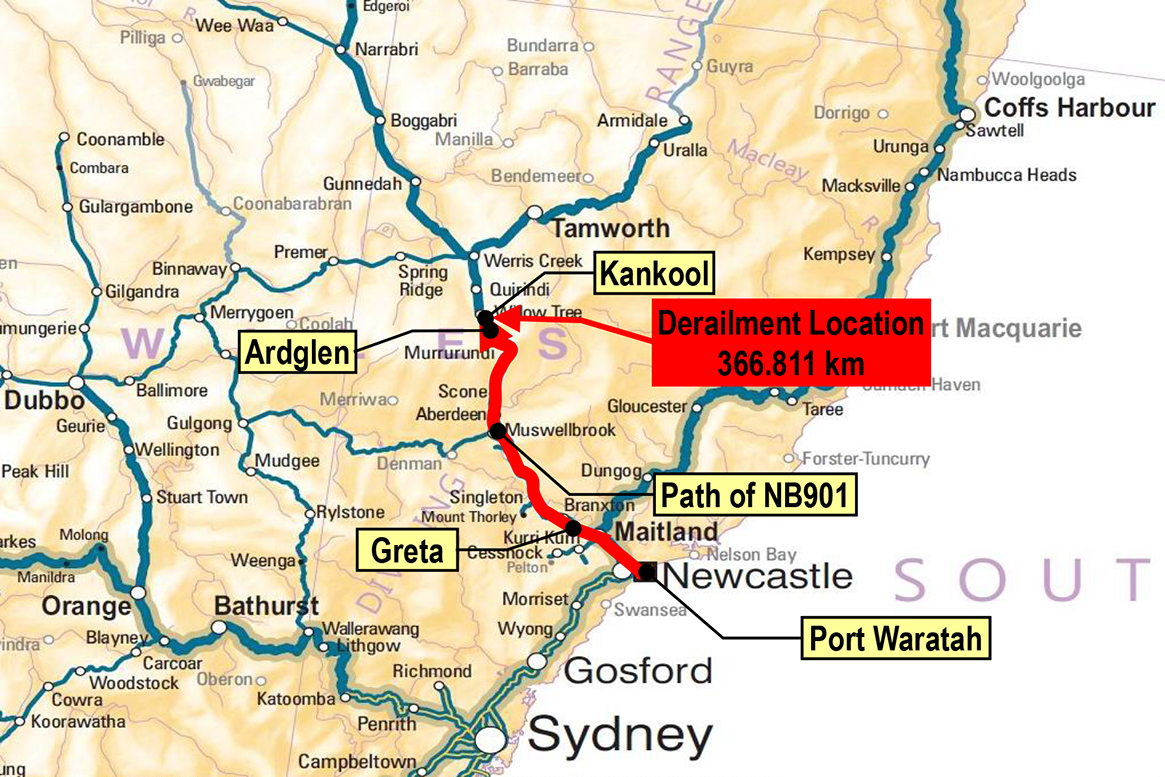
Source: Geoscience Australia, annotated by ATSB
Weather
Bureau of Meteorology records for the nearby township of Murrurundi indicated that weather conditions at the time of the derailment were cool, dry and clear. The minimum temperature was 14.3 °C and the maximum was 32.0 °C. The weather was found not to have contributed to the incident.
Train information
General
NB901 consisted of three locomotives (TT128, 9206, TT116), two RHDH type wagons and 80 NHDH type wagons. It had a total mass of 2,293 tonnes and measured 1,325 metres in length. Each wagon weighed 23 tonnes tare.
Train braking systems
Although the locomotives were of different classes, each was fitted with ECP (service) braking and dynamic (regenerative) braking systems that were fully compatible and controllable from the leading locomotive.
Traditional train pneumatic brakes rely on the driver’s brake controller producing a pneumatic signal relayed down a brake pipe along the train to activate a pneumatic valve and triggers air to be pathed to the brake cylinders. The force generated by the air compressing in the brake cylinders actuates a mechanical linkage and a force is applied to a friction material against the wheel tread face to brake the train. There is a time delay in braking between the front of the train and the rear of the train due to the propagation rate of the pneumatic signal along the brake pipe.
ECP braking is an electronically controlled pneumatic system that applies or releases the service brake on each wagon almost simultaneously at the driver’s command. The system connects from the locomotives to each wagon both electrically and pneumatically. Also incorporated in the system is a shadowing feature that automatically applies the brakes should the electrical or pneumatic connections between the wagons break, such as when the train parts and the train air supply inadvertently vents to atmosphere. With ECP, an electronic signal is sent to a car control device (CCD) mounted on each wagon and initiates the brakes to apply simultaneously along the length of the train. The CCD triggers an air flow to the brake cylinders and braking occurs in a similar fashion to the traditional pneumatic brake system.
The ECP system has the ability for the incremental application or release of the brakes to provide the driver with a greater control of the train braking. In downhill situations, the driver can apply dynamic braking and apply the ECP brakes in small proportioned applications to stabilise the train and improve train handling.
Dynamic braking is a function on locomotives designed to reduce wear and heat in the friction type braking equipment on the train. Being a supplementary system, it provides an additional means to control train speed however, it is not a substitute for the train air brakes (electronically controlled or otherwise). Normally, electrical power is supplied to rotate the traction motors that in turn drive the locomotive wheels. With dynamic braking, the function of the traction motors is reverse and the traction motors become electrical generators. When using dynamic braking, the current generated by the traction motors is converted to heat and dissipated through an electrical resistor bank on the locomotive. Increasing or decreasing the amount of electrical resistance varies the retardation or a braking effect on the rotating locomotive wheels and the train.
Maintenance history
Wagon maintenance history records indicated that the following scheduled inspections had been conducted on unit train 29 that formed NB901:
|
Time/Date |
Location |
Inspection Type |
Comments |
|
0155, 15 February 2015 |
Greta |
ECP Train Integrity Checklist |
Found fault indication on computer screen |
|
0130, 15 February 2015 |
Greta |
Unit Information Sheet. |
Found brake shoe key missing R2, NHDH 95433V |
|
9 February 2015 |
Greta |
FX (Full Examination) test[7] __________ |
|
|
4 August 2014 |
Port Waratah |
Scheduled Maintenance Inspection |
The records also indicated all safety critical defects located during the inspections had been actioned in accordance with maintenance standards.
Wagon couplings and in-train force control
The RHDH-type wagons were permanently coupled as a 2-pack set using a fixed drawbar coupling. The NHDH-type wagons were coupled as 4-pack sets using fixed drawbars. Automatic couplings connect the sets together and to the locomotives.
Fixed drawbar coupling assemblies are used to reduce play and to transmit longitudinal in-train forces, both tensile and compressive, generated between the wagons when the train is in motion. Resilient draft gear packages also form part of the assemblies for both drawbar and automatic couplings to dampen the in-train forces between wagons.
Train crew
General
Both crew members were attached to the PN depot at Werris Creek. The driver had a total of 14 years rail experience, 10 of which were driving trains. The assistant driver had three years rail experience as a trainee driver.
Both crew members held the required qualifications and competencies to operate the train over the route. There were no medical restrictions on either crew member.
Fatigue
An examination of the rosters for the driver and the assistant driver for the previous 14 days did not identify any evidence to support fatigue management issues in relation to the train crew involved in the incident. After two book-off days, they worked day shifts locally on Friday before crewing another train from Werris Creek to Port Waratah on Saturday. At Port Waratah, they undertook an eight-hour rest break before signing on duty at 0100 to work NB901 from Greta back to Werris Creek.
PN use a fatigue management program based on the Fatigue Audit InterDyne (FAID) system in accordance with its SMS and there was no evidence that fatigue contributed to this incident.
ECP train handling procedures
In 2011, PN and ARTC entered into a project to increase the length and capacity of coal trains operating between Narrabri and Port Waratah from 72 wagons and 25 tonne axle load (TAL) to 82 wagons with a 30 TAL. As part of the project, ARTC, as track owner, was required to upgrade the track and its maintenance procedures prior to the commencement of the 30 TAL project while PN, as rolling stock operator, was required to review the ECP train handling guidelines.
PN engaged independent contractors to conduct the engineering analysis for the 30 TAL. The analysis included the testing of fully loaded trains operating over the route on 22, 23 and 24 March 2011. The tests were used to measure the traction forces, head end dynamic braking forces and banking forces on the trains. The analysis identified and initiated mitigation strategies for any potential issues associated with the increased train lengths and axle loads, particularly when ascending and descending the steep grades over the Liverpool Ranges. The Train Handling Guidelines for ECP trains were developed as a result of these tests.
Significantly, the testing and analysis did not include unloaded trains; as was NB901. As a result, the differences in the handling characteristics between loaded and unloaded trains were not considered and not included in the guidelines. Despite this, the trial results and the Train Handling Guidelines for ECP Trains were accepted by ARTC as track owner.
The guidelines were issued to train crews as a Local Safety Notice (LSN) dated 17 November 2014. The LSN specified the train handling requirements for train crews operating ECP-braked trains in the Hunter Valley and North West Plains region.
The LSN required the following actions by the driver:
- dynamic brake be set up in preparation for the descent of grades
- an initial ECP (service) brake application of 20% to 30% (as per driver’s computer screen display) be applied (to keep the train stretched)
- the use of dynamic braking up to 250kN[8] tractive effort
- management of the train braking to maintain constant tractive effort on the train. This included blending with ECP braking should the forces under dynamic braking exceed the prescribed 250kN.
Event recorder analysis
Analysis of the on-board event recorders from the three locomotives of NB901 for the five-kilometre section between Ardglen and Kankool indicated the following:
- Although dynamic braking was set up and engaged at the commencement of the descent at Ardglen, the LSN-prescribed 20% to 30% ECP brake application was not made
- The speed of the train exceeded the posted speed limit of 50 km/h by 3 km/h and 9 km/h on two occasions during the descent. Despite this, on both occasions, only increased dynamic braking was used to reduce the train speed
- Locomotive tractive effort peaked at 338kN on the approach to the point of the derailment (366.811 km). At this time, maximum dynamic braking was engaged with the coupling between the third locomotive and the leading wagon was most likely bearing the full weight of the trailing train
- The train was travelling at 32 km/h when it derailed at 0510.26, still with peak dynamic braking applied
- The first indication of the derailment registered at 0513.04 when the train air supply pressure fell, indicating an automatic (emergency) brake application on the train. The train was travelling at 54 km/h at the time with dynamic braking engaged and 111kN tractive effort. The automatic brake application coincided with the train parting and the train air supply venting to atmosphere at No.51 catchpoints at 368.587 km
- The locomotives continued until the driver brought them to a stand at 0514.25 at 369.450 km using the independent brake system on the locomotives.
In total, the leading wagon travelled approximately 1,950 metres in a derailed state before parting from the rear locomotive at the catchpoints and coming to rest. The locomotives continued for a further several hundred metres before coming to a stand.
Track information
General
NB901 was operating on part of the Main North line leased by the ARTC from the NSW Government. The single line, standard gauge track[9] consisted of continuously welded 60 kg/m rail fastened to concrete sleepers by resilient clips. Crossing loops along the single-line track permitted train-crossing movements.
Track speed for freight trains descending the ruling 1:40 gradient from Ardglen to Kankool varies between 50 and 60 km/h. Track curvature in the section varies above 240 metres radius.(Figure 2)
The section between Ardglen and Kankool was not equipped with a track-mounted wheel flange lubrication system to reduce friction or wear between the wheel and the rail on curves.
Figure 2: Curve and Gradient Diagram
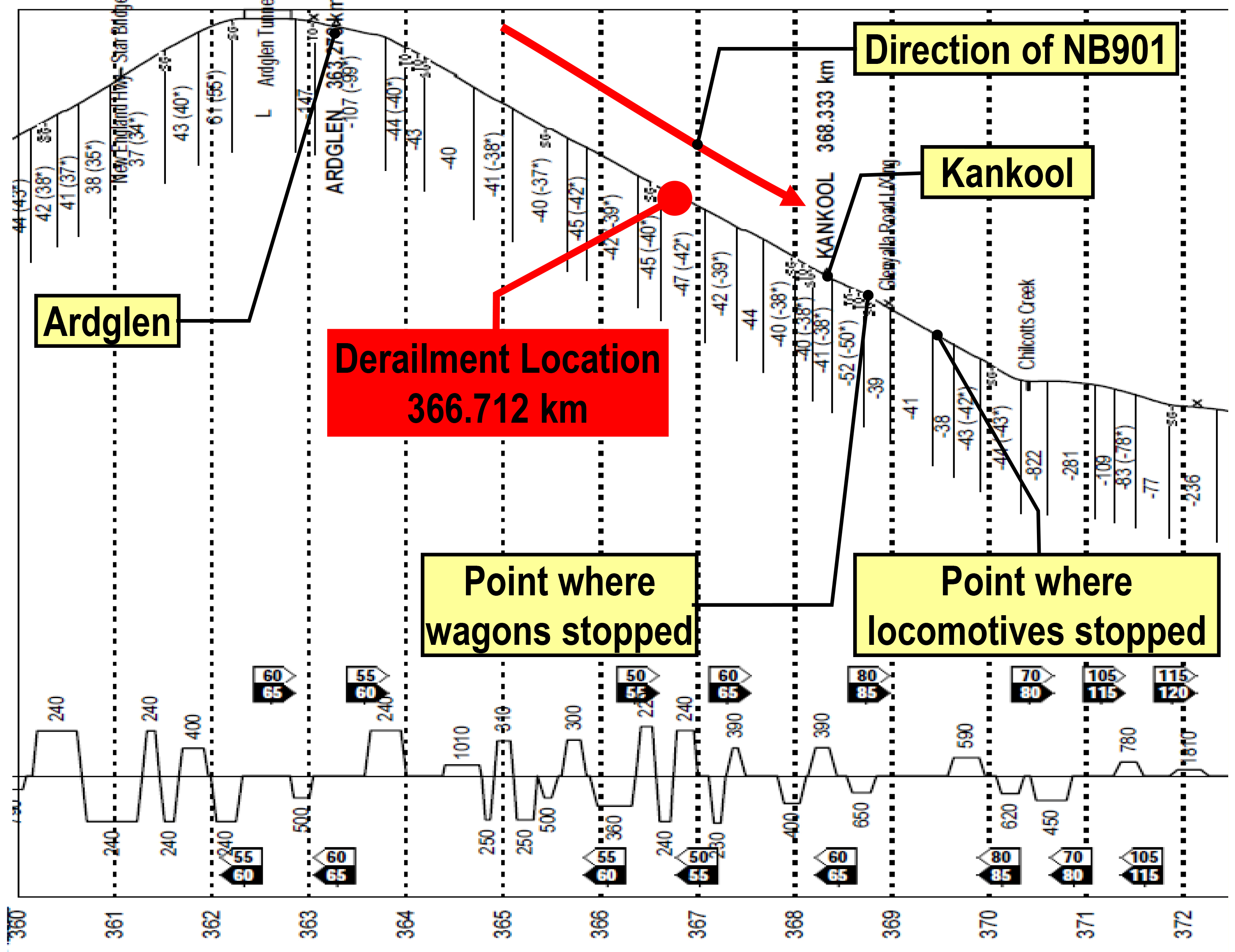
Source: ARTC with annotation by ATSB
Track maintenance
Track maintenance history records indicated that the following inspections had been conducted recently in the vicinity of the derailment site:
|
Date |
Inspection Type |
Kilometrage |
Comment |
|
6, 10 and 13 February 2015 |
Collapsed embankment inspection |
367.080 km |
|
|
3, 6, 10 and 13 February 2015 |
Track Patrol (Hi-rail, walk or train) |
289.015 to 411.175 km |
|
|
3, 6 and10 February 2015 |
Inspect bunching pointsvia track patrol single track |
289.015 – 411.175 km |
|
|
3 February 2015 |
Culvert inspections due to30 TAL project |
366.746 km |
|
|
3 February 2015 |
Culvert inspections due to30 TAL project |
367.080 km |
|
|
23 January 2015 |
Service rail lubricators |
289.015 to 411.175 km[10] __________ |
|
|
22 January 2015 |
Inspect erosion and take photos |
365.200 km |
|
|
23 December 2014 |
Unscheduled asset inspection: Culvert inspection due to 30 TAL project |
366.746 km |
|
|
19 December 2014 |
Unscheduled asset inspection: Culvert inspection due to 30 TAL project |
367.080 km |
|
|
18 December 2014 |
Points and crossings general inspection |
368.670 + 368.583 (51, 52, 52a + 53 catchpoints, Kankool) |
1 month overdue (within 36 day latitude) |
|
9 December 2014 |
Earthen works general |
289.015 to 411.175 km |
Due 29 October 2014 (over 36 day latitude) |
|
7 December 2014 |
Speno ultrasonic test |
364.757 to 378.350 km |
|
|
31 August 2014 |
Rail profile grind |
366.750 km to 367.000 km |
Next scheduled 17 December 2014 (not done) |
|
16 July 2014 |
Rerailing and tamping for30 tonne axle load |
365.700 to 365.830 km 366.750 to 366.850 km |
The records also indicated that, apart from the rail profile grinding, all other inspections were conducted within the required time intervals.
Train Control
ARTC’s NCCN at Broadmeadow manages the train movements between Port Waratah and Narrabri. The signalling system operates in accordance with ARTC Network Rule ANSY 500 Rail Vehicle Detection System. NB901 was operating under clear signals at the time with no proposed crossing movements before Werris Creek.
Post incident examinations
Track
The track was examined post-incident with the following observations:
- A point of mount (POM) on the down rail at 366.811 km, shortly after it had transitioned into a 240 metre radius curve, indicated that NB901 had derailed after climbing the rail head at that point. (Figure 3) The wheel mark continued for approximately one and a half metres to a point of drop (POD) where the derailed wheels had dropped from the railhead onto the sleepers and track bed.
Figure 3: Point of mount and point of drop on the down side rail
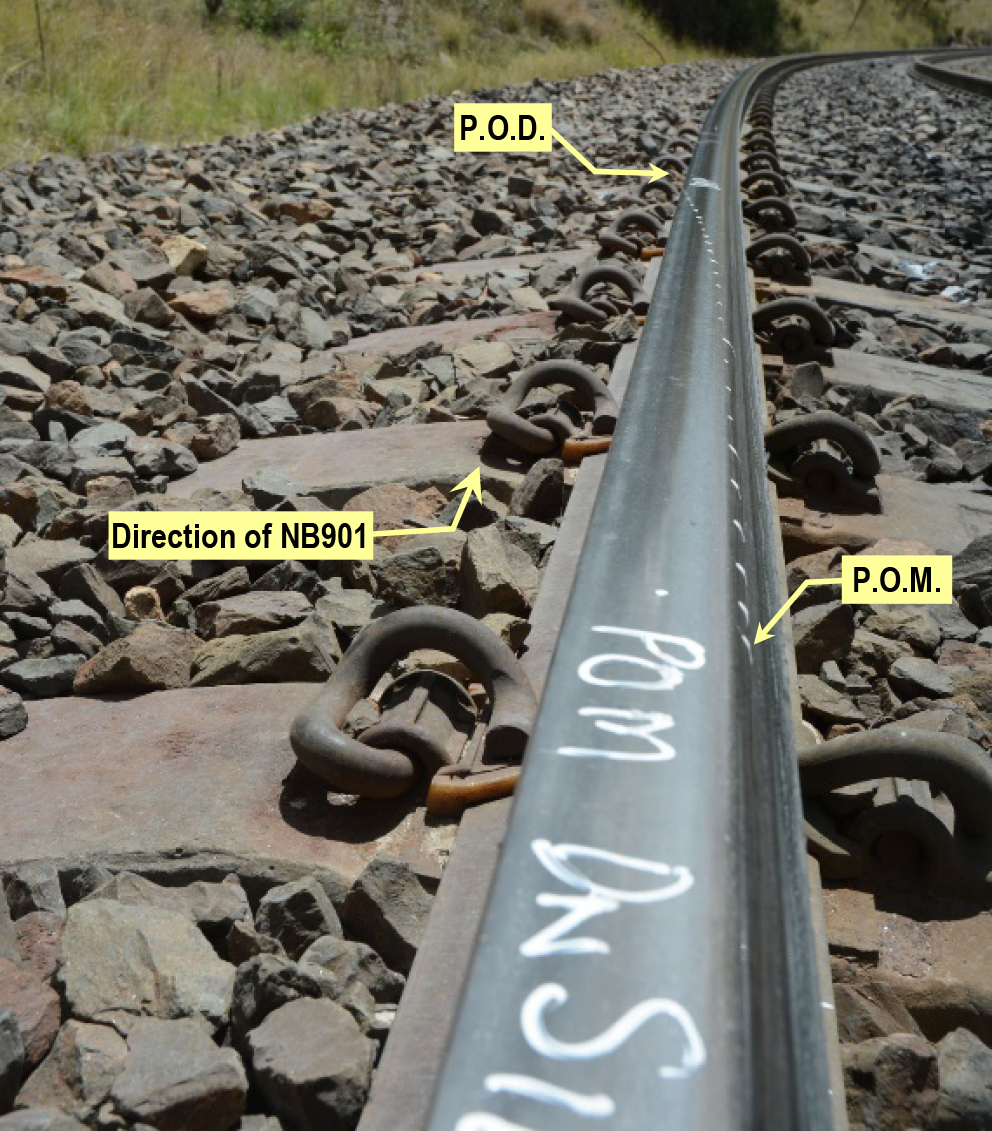 Source: ATSB
Source: ATSB
- Around the area of the POM, significant wear was observed to the gauge (inside) face of the down side rail. (Figure 4) Although the wear was still within prescribed ARTC limits, the worn gauge face was inducing full flange contact between the wheels and the railhead as trains traversed the curve. Similar rail wear conditions were also observed on the opposite up side rail on the reverse 240 metre curve prior.
Figure 4: Diagram of rail wear, contact point and forces at POM
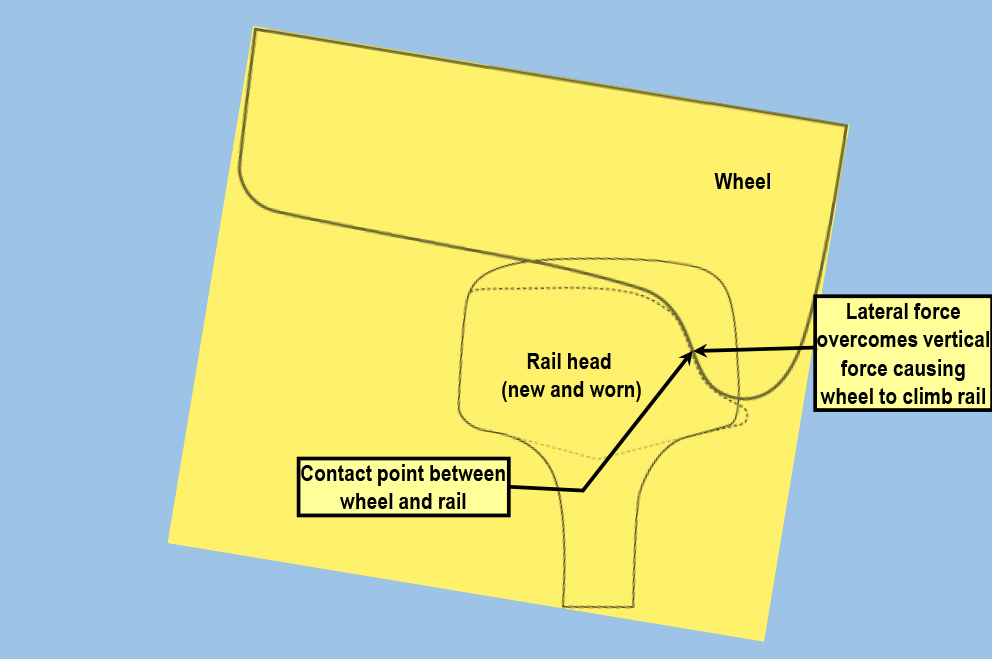 Source: ARTC, with annotation by ATSB
Source: ARTC, with annotation by ATSB
- There were no rail lubrication systems fitted to this section of track or any evidence of recent rail lubrication leading up to the incident site. This was despite recommendations made in an ARTC report for higher axle loads in the Hunter Valley that the numbers and placement of lubricators be assessed to optimise lubrication effectiveness over the section between 357.000 to 374.000 kms (Pages River to Willow Tree).
- The concrete sleepers between the POM and No.51 catchpoints exhibited chipping on their approach side consistent with the derailed wheels running along the track. (Figure 5).
Figure 5: Sleeper damage caused by dragging bogie
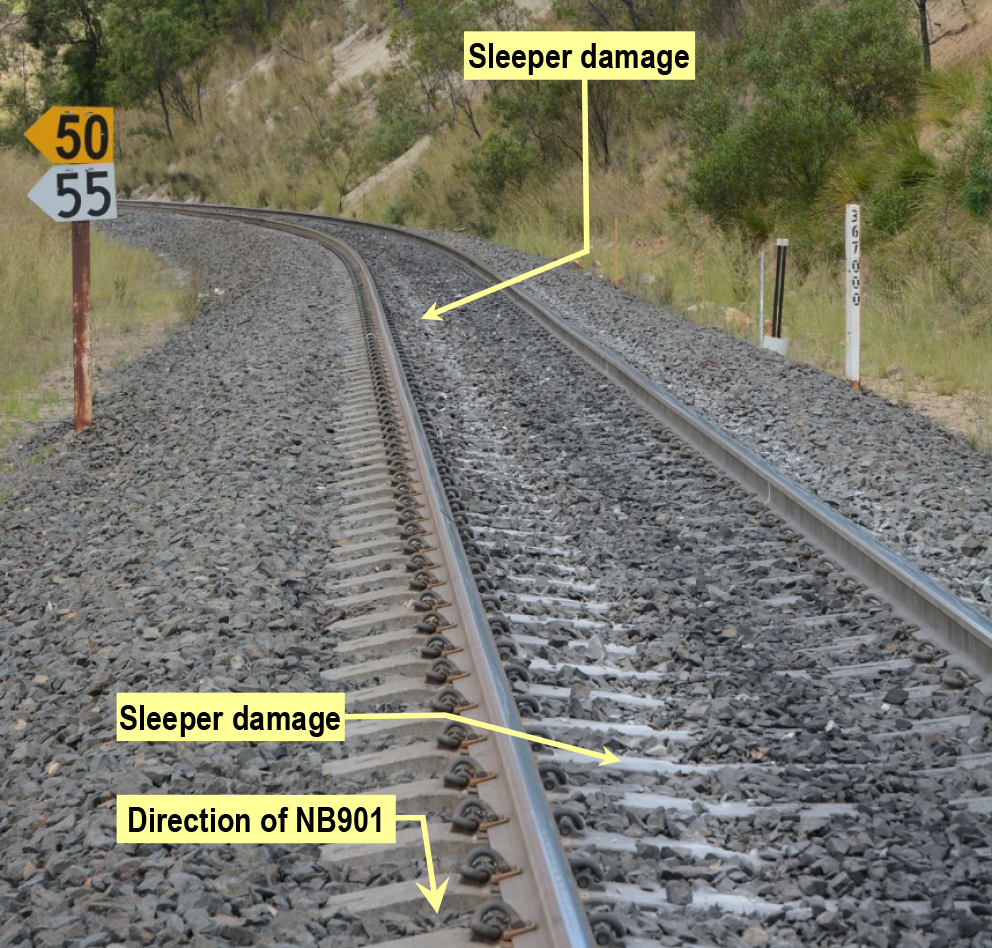 Source: ATSB
Source: ATSB
A number of timber sleepers prior to No.51 catchpoints also exhibited flange marks on the top of the sleepers and corners of the base plates consistent with derailed wheels running over the sleepers
In the vicinity of No.51 catchpoints:
- the electric point machine and drive rods for the catchpoint suffered extensive damage
- the tip of the switch blade for the catchpoint was shattered
- the up rail had broken at a weld.
Most of the damage to No.51 catchpoints occurred when the derailed wheels tracked on the inside runoff rail of the catchpoints, breaking the up rail past the catchpoints and directing the following wagons off the track towards the cutting embankment. (Figure 6)
No.52 and No.53 points were destroyed.
Figure 6: Damage at No.51 Points
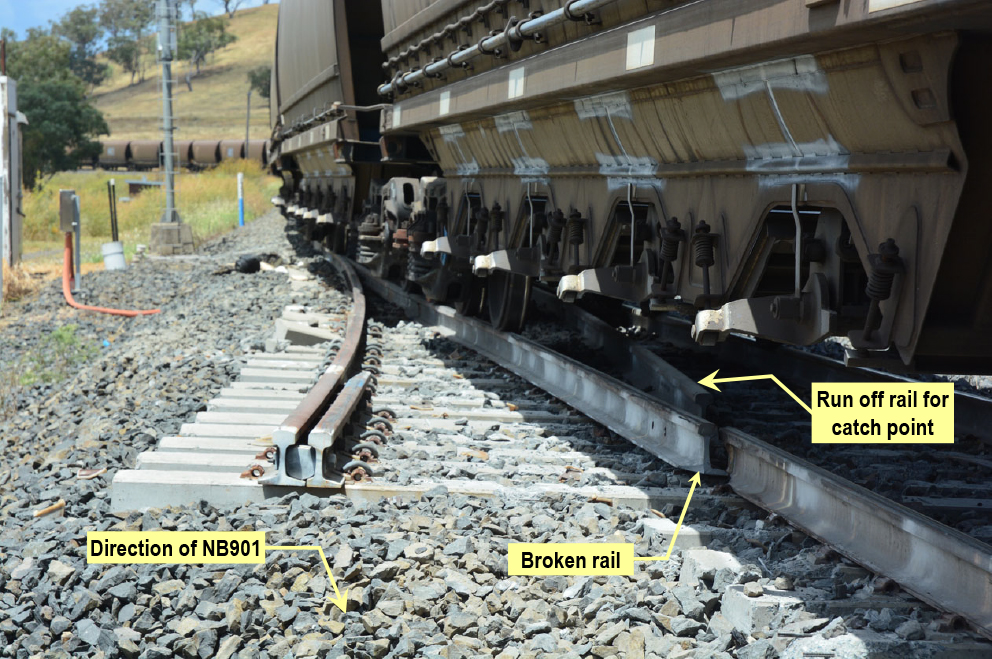
Source: ATSB
Rolling stock
NB901 was examined onsite on the day of the incident with the following noted:
- The 63 wagons remaining on track were in a serviceable condition with no obvious defective safety critical components
- A king pin, various side bearer components and a number of spring nests had been ejected from a derailed wagon and were located on the track in an area between 30 and 150 metres after the POM. (Figure 7) The presence of these components at this point indicated that a wagon body had lifted from a bogie during the derailment sequence.
Figure 7: Bogie springs on track
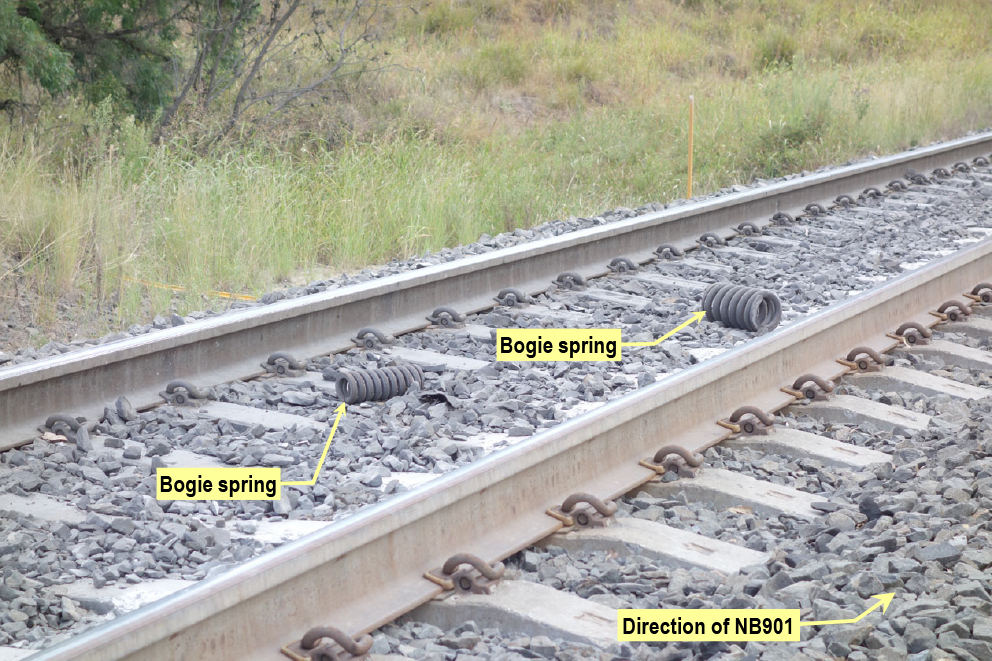
Source: ATSB
- Although dragged from the POM to the catchpoint, the derailed bogie tracked parallel to the track centre during its passage through the section. (Figure 8) Despite lifting at one point during the derailment sequence, the alignment of the flange marks also indicated that the derailed bogie had remained attached to the wagon body, most likely by the connecting brake lever (that was later noted still attached to the wagon body). Associated with this were wheel impact or wear marks on the external face of end slope panel of the leading end of the wagon. The wheel marks on the end slope panel were further evidence that the wagon body had lifted off the bogie during the derailment sequence.
Figure 8: Wheel impact damage on track
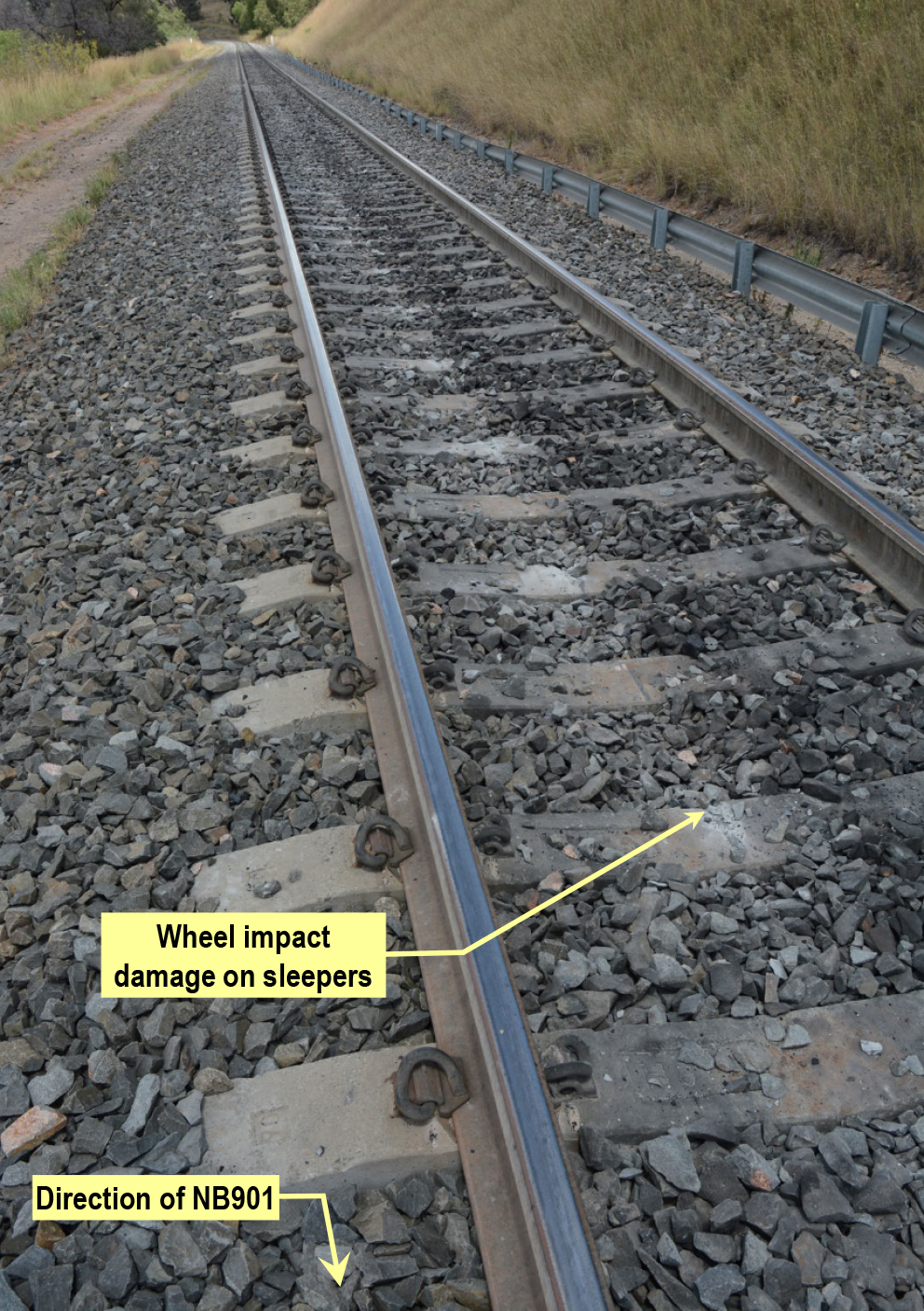 Source: ATSB
Source: ATSB
- While the derailed wagons concertinaed in the cutting approximately 300 metres south of the Glenyalla Road level crossing, the locomotives continued before coming to a stand several hundred metres beyond the main incident site. Examination indicated that they were in a serviceable condition with no obvious defective safety critical components. However, minor damage was observed on the rear of the third locomotive, TT116, and this most likely occurred during separation from the leading wagon, RHDH 99071M. The damage consisted of minor body panel damage, dislodgement of the connector cable for the ECP brake system, dislodgement of the receptacle box for the ECP brake system cable from its mounts and high force impact marks on the automatic coupler shank. (Figure 9)
Figure 9: Damaged electrical equipment on rear locomotive TT116
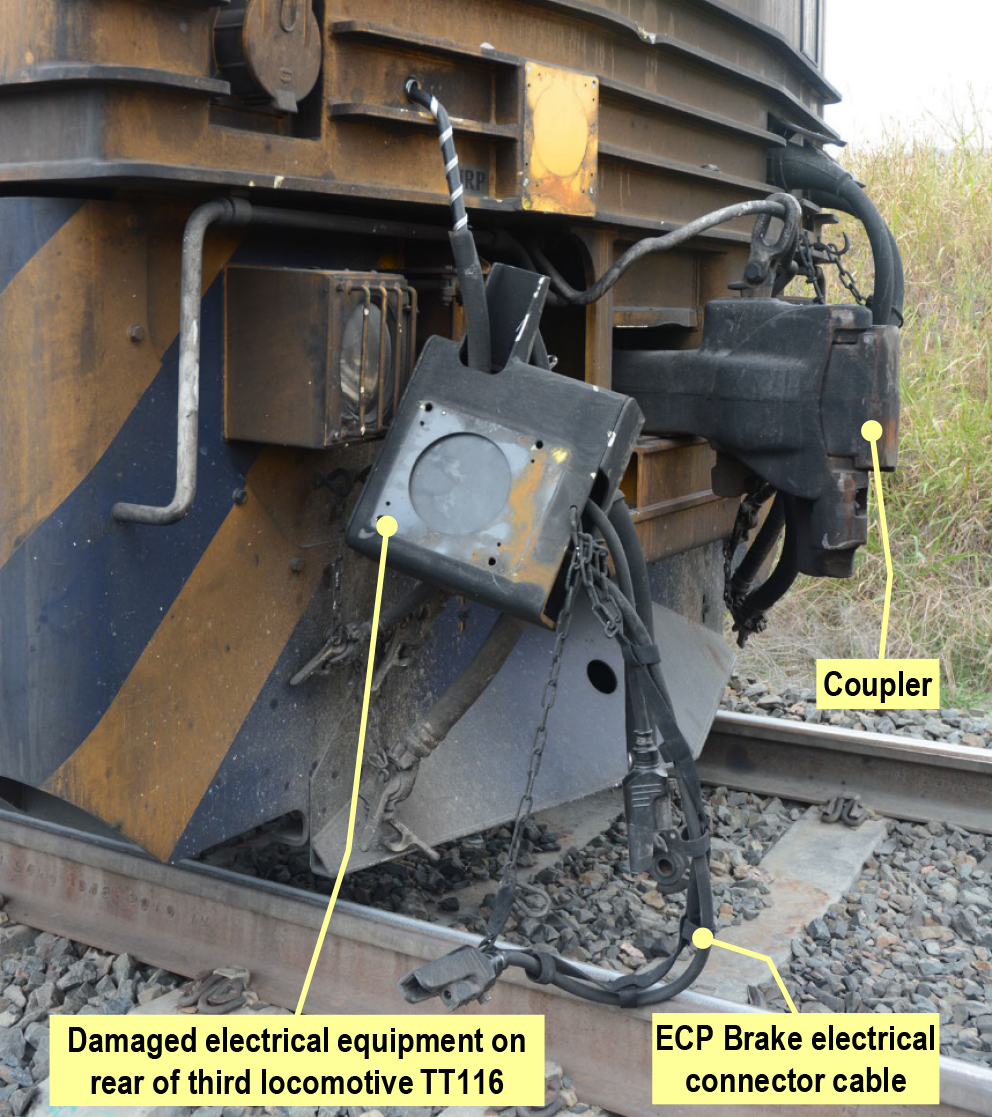 Source: ATSB
Source: ATSB
- One wagon wheel set from a bogie had detached and landed in grassy vegetation alongside the New England Highway close to passing road traffic. (Figure 10)
Figure 10: Position of wheelset near New England Highway
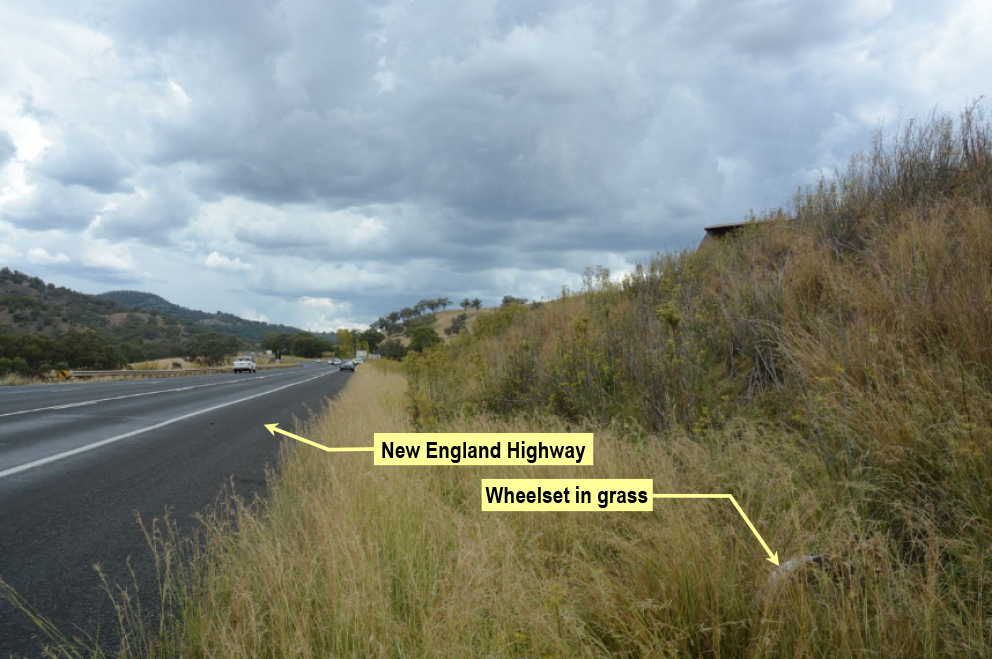
Source: ATSB
- The derailment of wagon RHDH 99071M initiated the derailment of a further 18 wagons which came to rest in a concertinaed pattern within an 80 metre cutting. However, due to their unsafe position, they were not examined on-site in detail. A protection order was subsequently placed on the wagons for their recovery to holding facilities at Werris Creek and later safe examination.
The derailed wagons were examined at Werris Creek on 24 February 2015 with the following observations:
- The damage to the bogie frames and wagon body of RHDH 99071M was consistent with that sustained in the derailment
- Significant wear and flattening had occurred on the flange tips of the left side wheels from the leading bogie of the leading wagon, RHDH 99071M. This damage was consistent with derailed wheels running on the ballast for a significant period. The condition of the wheels indicated that this was most likely the first wagon to derail in the incident. No wheel sets from the other derailed wagons exhibited such flange damage. (Figure 11)
Figure 11: Damage on L3 Wheel
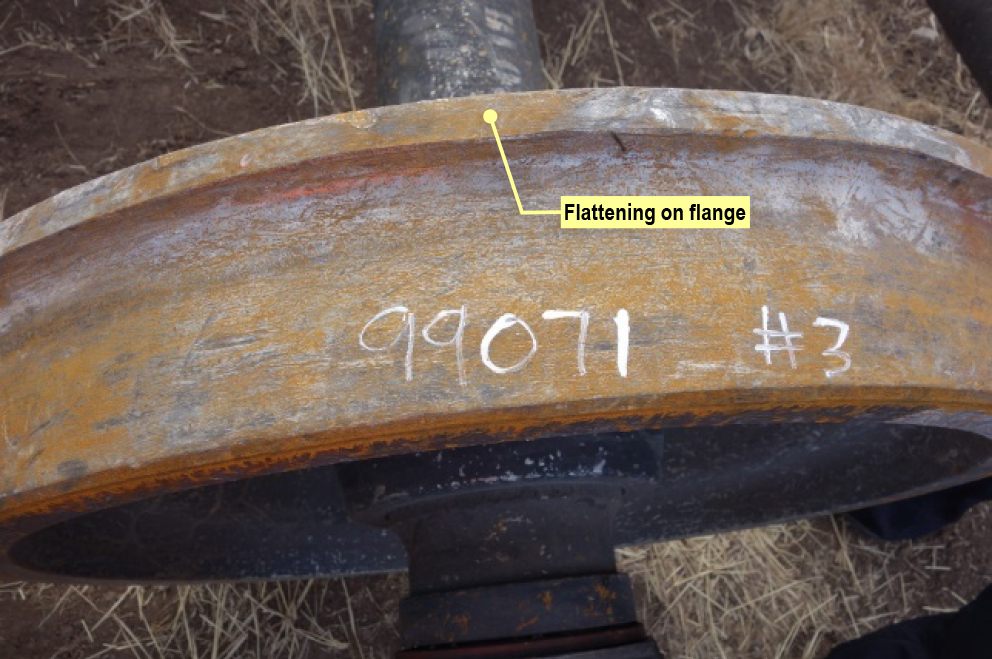
Source: ATSB
- Measurement of the two wheelsets from the leading bogie of RHDH 99071M indicated that they were within prescribed tolerance. This included the flange thicknesses that were near full wheel profile. No abnormal or excessive wear patterns were observed on the wheels other than the flange wear and flattening. Measurements from the other wheelsets inspected also indicated they were within tolerance with no abnormal wear patterns or conditions.
- There were no abnormal wear patterns or conditions observed in the centre castings or side-bearer housings of the derailed wagon or its bogies
- There was no evidence of any contamination on the wheel flanges
- The presence of minor wheel impact or wear marks on the external face of the wagon body end slope panel indicated that the derailed bogie had remained tethered to the wagon, but did not dislodge, when dragged
- The damage to the remaining wagons was consistent with that sustained in the derailment. The safety critical components of these wagons were in a serviceable condition
- There was significant twisting and deformation observed on the rubber element plates in the draft gear packages on various wagons that dampen the longitudinal in-train forces between wagons. However, this damage did not appear to be recent or accident related. (Figures 12 and 13)
Figure 12: Typical damage to rubber element plates
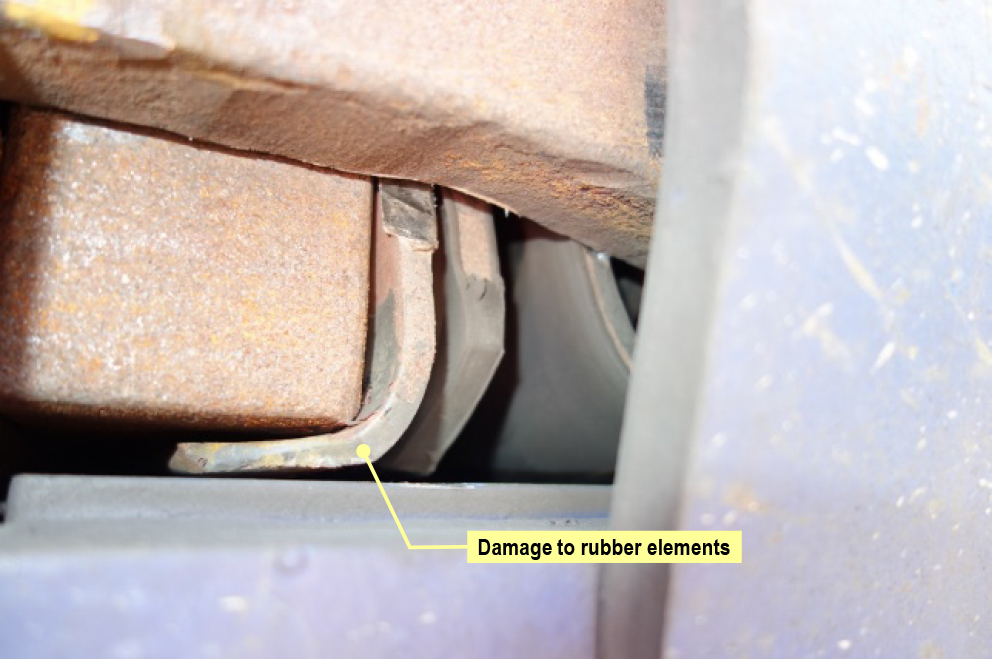
Source: ATSB
Figure 13: Diagram of draft gear and fixed drawbar arrangement
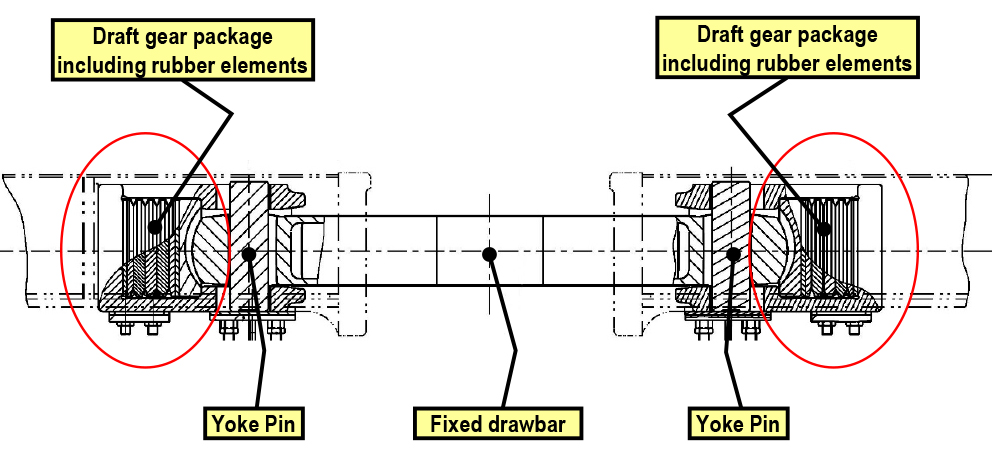
Source: PN annotated by ATSB
Although controlling in-train forces, it could not be positively concluded that the condition of these rubber elements contributed any role in the derailment sequence. Despite this, PN commenced a change-out program for the draft gear package. Amongst other issues, PN also commenced a program of continued monitoring of the train handling techniques for drivers and introduced an updated inspection regime for the replacement draft gear packages.
__________
- This inspection includes a full mechanical inspection of the train as well as a brake pipe leakage test, air brake inspection and test, brake retention test, and brake pipe continuity test.
- Tractive effort per locomotive as displayed on the driver’s annunciator panel.
- The terminology used for track with a width of 1435 mm between running rails.
- This inspection covered all rail lubricators between Muswellbrook and Werris Creek.
Introduction
The derailment occurred when the L3 wheel on the leading wagon of NB901, RHDH 99071M, climbed up and over the railhead. (Figure 14) With the two pack RHDH wagons immediately behind the locomotives, the derailed wagon, being first in the consist, bore considerable compressive forces on the first drawbar. These forces were the result of the downhill run in of the train, the curving resistance as it transitioned into a tight 240 metre radius curve in the track and the locomotives being dynamically braked.
Two main factors were considered likely for the wheel to climb. The first factor related to the train management of NB901 as it traversed the Ardglen to Kankool section and the non-conformance to the LSN. The second factor related to the wheel/rail interface.
Figure 14: Wheel configuration of first derailed wagon
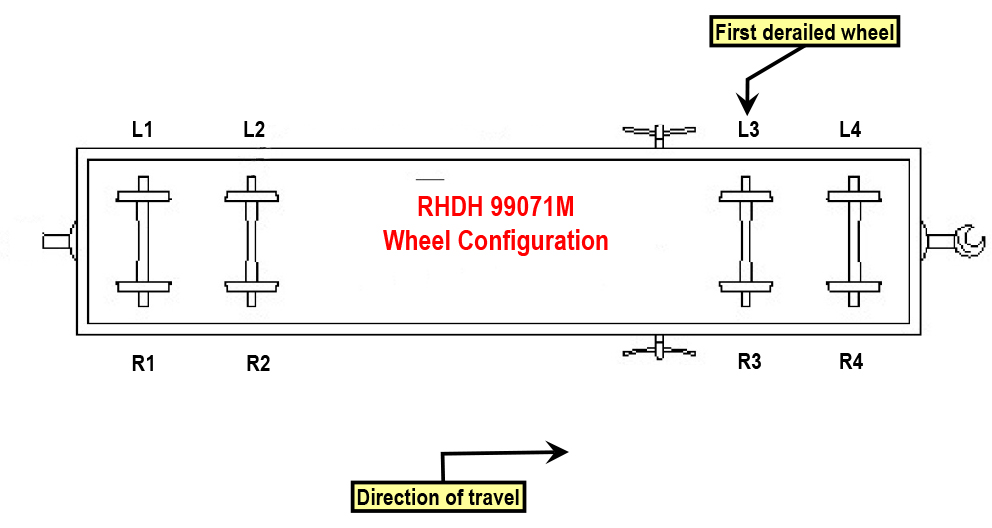
Source: PN annotated by ATSB
Conformance to Pacific National Local Safety Notice
PN developed the LSN as part of a hazard mitigation strategy to address the hazard of in-train forces within its 82 wagon trains. The strategy also included the use of blended braking (ECP plus Dynamic) as the control measure for the hazard.
The locomotive event recorder data extracted from all three locomotives indicated that the required 20% to 30% ECP brake application had not been made in accordance with the LSN after the train crested the grade at Ardglen. Instead, only dynamic braking was engaged as NB901 commenced the descent towards Kankool. With the wagons only part way over the crest, the train remained in a ‘stretched’ condition.
As the train crested the peak of the grade, without any ECP braking applied to maintain the stretch and stabilise the train, the wagons compressed against the locomotives under dynamic braking. As a result, the compressive forces on the locomotive couplings, measured as tractive effort on the driver’s enunciator panel, increased markedly.
As the dynamic braking increased to maximum, the retardation effort further increased and eventually exceeding the LSN prescribed limit of 250kN. However, the driver did not make the required ECP brake application to stretch the train and reduce the tractive effort once it exceeded the LSN limits. The sole use of dynamic braking to manage train speed is common when driving older trains that are equipped with only conventional air brake systems.
Train crew records indicated that the driver of NB901 had long-term experience with conventional air-braked trains and limited experience with trains fitted with an ECP braking system, although deemed competent for both braking systems.
At interview, the driver stated that it was usual practice for unloaded trains to descend the grade from Ardglen to Kankool using dynamic braking only. Yet, despite an ongoing competency assessment program by PN, the driver recalled only ever undergoing one assessment on ECP trains descending steep grades. This assessment was conducted on a loaded train travelling from Werris Creek to Newcastle. However, the non-conformance to the LSN and the use of dynamic braking only on the steep declines was not picked up during the assessment.
Two over speed events of 3 km/h and 9 km/h over the posted 50 km/r speed board also occurred during NB901’s descent from Ardglen to Kankool. However, ECP braking was not used in conformance with the LSN to manage NB901’s speed or the retardation effort placed on the train.
The LSN made no distinction about any handling differences between loaded and empty trains. However, train crews considered that the LSN requirements were guidelines and related only to heavier, loaded trains, particularly as they required greater speed control when travelling towards Newcastle in the opposite direction of NB901.
Because of the non-conformances identified with the LSN, in March 2015, PN revised the LSN to clarify that it related to both loaded and unloaded trains. In June 2015, as well as reiterating the train management procedures for loaded and unloaded trains, PN further prescribed that the speed and tractive effort of trains operating in an empty condition between Ardglen and Chillcotts Creek be reduced to a maximum of 40 km/h and 230kN. In October 2015, PN reduced the area of the 40 km/h speed limit back towards Kankool.
Wheel/rail interface
Records indicated that the rails in the vicinity of the POM had been replaced as part of the 30 TAL project in July 2014. In August 2014, the profile of rails was ground so as to:
- control the contact points on the flanges of train wheels
- reduce friction between the wheel and the rail
- reduce wheel and rail wear.
The records also indicated that the rails were programmed for replacement due to railhead wear in December 2014. However, this had been deferred to ARTC’s 2015 – 2016 re-railing program. The rails were replaced post incident during track repairs.
Despite the refurbishment of the rails in August 2014, the down (outside) rail at the POM had worn heavily on the gauge face and railhead. Although still within wear limits, the wear pattern indicated that the wheels were making full flange contact on the gauge face while traversing the curve. Subsequent measurement of the railhead wear indicated a 27% material loss, this was within ARTC’s 32% maximum wear criterion. Further, the gauge face of this rail had worn to an angle of 16.5 degrees off vertical. Although within ARTC’s 26-degree criterion, the angle promoted wheel climbing due to the lack of clearance between the flange tip and the rail. Subsequently, when the train compressed, the combination of elevated lateral and longitudinal forces, a light wagon weight and the full flange contact on the outside rail all increased the likelihood for a wheel to climb. The likelihood for wheel climb is particularly greater on wheels with full thickness flanges where flatter profile angles and less flange/rail clearance promote climbing on the railhead in comparison to worn wheels. The flanges on the L3 wheel of RHDH 99071M were near full thickness.
At the time the wheel climbed the rail, the wagon was compressed between the locomotives and the other 81 wagons of the train. Without any ECP brake application made to keep the train stretched, the in-train forces compressed the wagons against the locomotives when dynamic braking was engaged. This was evident by the position of various bogie components on the ground in close proximity after the POM. While normally confined in the centre casting assembly of the bogie, their position relative to the POM suggests that the in-train forces were of such to lift the wagon body completely off the bogie. Despite the presence of light but continuous wheel marks on the railhead, the location of the expelled bogie components indicated that the wagon body had lifted after the wheel had derailed. (Figure 3)
Although the wagon body had lifted, the derailed bogie remained connected to the wagon body by the handbrake assembly remaining intact. Significantly, event recorder data indicated that the tractive effort on the locomotives was exceeding the 250kN LSN limit at the same time L3 wheel climbed the rail.
Both the running and gauge faces of the railhead were clean, dry and shiny; and without contamination from any nearby vegetation or sullage from passing trains. Further, there were no abnormal surface conditions on the running faces of the rail. As a result, all these conditions combined to cause a higher coefficient of friction between the rail and the wheel flange.
There were no abnormal conditions observed on the wheel tread or flange of L3 wheel with recent machining marks still evident. Further, despite the tight track curvature over the Liverpool Ranges, there was no evidence of any flange lubrication on the wheels of the derailed wagons. This indicated that no lubrication transfer had occurred when passing over prior flange lubrication systems. ARTC have subsequently installed additional flange lubricators in the section between Kankool and Ardglen.
Summary
The L3 wheel of the leading wagon RHDH 99071M climbed the down (outside) rail and derailed at 366.811 km when the lateral and longitudinal in-train forces of the train exceeded the vertical forces keeping the wagon on significantly worn track. Although the wear to the rails was within ARTC specifications and standards, compounding the likely causes of the derailment were a combination of full flange contact by the wheel, a lack of lubrication on the rail and dry weather conditions. Subsequently, the wagon body also lifted off the bogie. The in-train forces were not adequately managed because an ECP brake application, designed to keep the train stretched and control the in-train forces, was not made as prescribed by the LSN. The derailed wheel then continued undetected until it struck No.51 catch points where the following 18 wagons also derailed. The remainder of the train stayed on track.
From the evidence available, the following findings are made with respect to the derailment of Pacific National empty coal service NB901 at Kankool NSW on 15 February 2015. These findings should not be read as apportioning blame or liability to any particular organisation or individual.
Safety issues, or system problems, are highlighted in bold to emphasise their importance. A safety issue is an event or condition that increases safety risk and (a) can reasonably be regarded as having the potential to adversely affect the safety of future operations, and (b) is a characteristic of an organisation or a system, rather than a characteristic of a specific individual, or characteristic of an operating environment at a specific point in time.
Contributing factors
- The derailment of NB901 occurred when the heavy use of the dynamic brake without an accompanying ECP brake application generated excessive in-train forces causing L3 wheel of the leading wagon RHDH 99071M to climb the railhead on the down rail as it traversed a tight curve.
- The derailment sequence was also promoted by a lack of lubrication on a rail with a raised coefficient of friction.
Other factors that increased risk
- The Local Safety Notice, which prescribed the train handling requirements when descending steep grades, did not adequately highlight that the procedures also related to empty trains.
- Development of the Local Safety Notice was based solely on the analysis conducted on loaded trains and without reference to empty trains.
Other findings
- There were two speed infractions during NB901s descent of the grade but not at the point of derailment.
Whether or not the ATSB identifies safety issues in the course of an investigation, relevant organisations may proactively initiate safety actions in order to reduce their safety risk. The ATSB has been advised of the following proactive safety actions taken in response to this occurrence:
Additional safety actions taken by Pacific National
Pacific National has advised of the proactive safety actions:
- the Local Safety Notice “Train Handling Guidelines for ECP Trains” was revised to also highlight the requirements for the working of empty Electronically Controlled Pneumatic braked trains on steep grades
- conformance to the requirements of the Local Safety Notice “Train Handling Guidelines for ECP Trains” were included as part of its train crew monitoring program.
Sources of information
The sources of information during the investigation included the:
- Pacific National
- Australian Rail Track Corporation
- Statements made by the crew members of NB901
- Pacific National Event Recorder Analysis Report
- Pacific National 30 TAL Project Analysis Report.
References
- Pacific National Local Safety Notice “Train Handling Guidelines for ECP Trains”
- ARTC Emergency Management procedure TA44
- RISSB Glossary of Railway Terminology Version 1.0.
Submissions
Under Part 4, Division 2 (Investigation Reports), Section 26 of the Transport Safety Investigation Act 2003 (the Act), the Australian Transport Safety Bureau (ATSB) may provide a draft report, on a confidential basis, to any person whom the ATSB considers appropriate. Section 26 (1) (a) of the Act allows a person receiving a draft report to make submissions to the ATSB about the draft report.
A draft of this report was provided to the following parties:
- Pacific National
- Australian Rail Track Corporation
- the Office of National Rail Safety Regulator
- the crew members of NB901.
Submissions were received from all parties, with the exception of the train crew of NB901. The submissions were reviewed and where considered appropriate, the text of the draft report was amended accordingly.
Purpose of safety investigationsThe objective of a safety investigation is to enhance transport safety. This is done through:
It is not a function of the ATSB to apportion blame or provide a means for determining liability. At the same time, an investigation report must include factual material of sufficient weight to support the analysis and findings. At all times the ATSB endeavours to balance the use of material that could imply adverse comment with the need to properly explain what happened, and why, in a fair and unbiased manner. The ATSB does not investigate for the purpose of taking administrative, regulatory or criminal action. TerminologyAn explanation of terminology used in ATSB investigation reports is available here. This includes terms such as occurrence, contributing factor, other factor that increased risk, and safety issue. Publishing informationReleased in accordance with section 25 of the Transport Safety Investigation Act 2003 Published by: Australian Transport Safety Bureau © Commonwealth of Australia 2018
Ownership of intellectual property rights in this publication Unless otherwise noted, copyright (and any other intellectual property rights, if any) in this report publication is owned by the Commonwealth of Australia. Creative Commons licence With the exception of the Coat of Arms, ATSB logo, and photos and graphics in which a third party holds copyright, this publication is licensed under a Creative Commons Attribution 3.0 Australia licence. Creative Commons Attribution 3.0 Australia Licence is a standard form licence agreement that allows you to copy, distribute, transmit and adapt this publication provided that you attribute the work. The ATSB’s preference is that you attribute this publication (and any material sourced from it) using the following wording: Source: Australian Transport Safety Bureau Copyright in material obtained from other agencies, private individuals or organisations, belongs to those agencies, individuals or organisations. Where you wish to use their material, you will need to contact them directly. |


